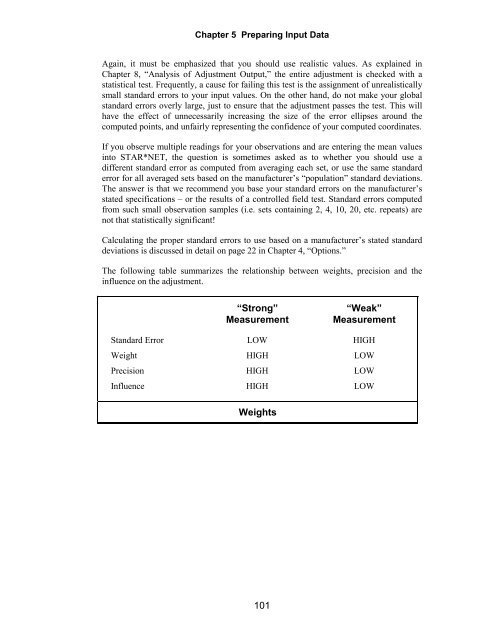STAR*NET V6 - Circe
STAR*NET V6 - Circe
STAR*NET V6 - Circe
Create successful ePaper yourself
Turn your PDF publications into a flip-book with our unique Google optimized e-Paper software.
Chapter 5 Preparing Input Data<br />
Again, it must be emphasized that you should use realistic values. As explained in<br />
Chapter 8, “Analysis of Adjustment Output,” the entire adjustment is checked with a<br />
statistical test. Frequently, a cause for failing this test is the assignment of unrealistically<br />
small standard errors to your input values. On the other hand, do not make your global<br />
standard errors overly large, just to ensure that the adjustment passes the test. This will<br />
have the effect of unnecessarily increasing the size of the error ellipses around the<br />
computed points, and unfairly representing the confidence of your computed coordinates.<br />
If you observe multiple readings for your observations and are entering the mean values<br />
into <strong>STAR*NET</strong>, the question is sometimes asked as to whether you should use a<br />
different standard error as computed from averaging each set, or use the same standard<br />
error for all averaged sets based on the manufacturer’s “population” standard deviations.<br />
The answer is that we recommend you base your standard errors on the manufacturer’s<br />
stated specifications – or the results of a controlled field test. Standard errors computed<br />
from such small observation samples (i.e. sets containing 2, 4, 10, 20, etc. repeats) are<br />
not that statistically significant!<br />
Calculating the proper standard errors to use based on a manufacturer’s stated standard<br />
deviations is discussed in detail on page 22 in Chapter 4, “Options.”<br />
The following table summarizes the relationship between weights, precision and the<br />
influence on the adjustment.<br />
“Strong”<br />
Measurement<br />
101<br />
“Weak”<br />
Measurement<br />
Standard Error LOW HIGH<br />
Weight HIGH LOW<br />
Precision HIGH LOW<br />
Influence HIGH LOW<br />
Weights

















